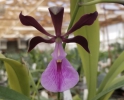|
|
|
|
|
| |
Established Seedlings of
Encyclia cordigera var. rosea 'MC7567' × self |
|
| |
|
|
| |
| Number: |
TN8636 |
| Name: |
Encyclia cordigera var. rosea 'MC7567' × self
|
| Type: |
self (What's that?) |
|
Click to Enlarge

Pod Parent Flower |
|
|
|
| |
For additional origin/habitat information supplied courtesy of
Charles and Margaret Baker, see further below, near the bottom of this page.
|
Temperatures we attempt to use in the lab & greenhouse:
| For Species: |
|
Spring, Summer, Autumn, Winter: days average 88°F, nights 66°F; best fit is Warm-Intermediate 87-64°F
(Source:
Baker's Web OSC) |
|
About the name...
| Etymology of |
cordigera |
|
From Latin "cordiger" carrying a heart (the shape of the labellum).
(Source:
Mayr & Schmucker 1998) |
| Etymology of |
Encyclia |
|
From Greek "enkyklein" to surround, in reference to the lip enclosing the column.
(Source:
Pridgeon 1992) |
| Etymology of |
rosea |
|
From Latin "roseus" pink.
(Source:
Mayr & Schmucker 1998) |
| Pronunciation of |
cordigera |
|
kor-DI-je-ra
(Source:
Hawkes 1978) |
| Pronunciation of |
Encyclia |
|
en-SIK-lee-ah
(Source:
Pridgeon 1992) |
| Pronunciation of |
rosea |
|
ROE-zee-ah
(Source:
Hawkes 1978) |
|
If you would like to direct someone to this web page, please copy and paste this URL into your email:
http://troymeyers.com/d?128636
|
ESTABLISHED SEEDLINGS
of these are not currently available, but we have some maturing in the greenhouse and expect to offer them in the future.
There is 1 item with
1 plant per
item that will be considered for sale later.
Click here to see if we have flasks available.
|
|
|
| |
The origin/habitat information below is supplied courtesy of Charles and Margaret Baker
The following information is based on the name of the plant provided by the donor, and assumes that the name is correct. If the plant has been misidentified, then the following information may not be correct.
This text is copyrighted by the Bakers and may not be reproduced without permission.
ORIGIN/HABITAT: Distributed from southern Mexico, through Central America,
the West Indies, and into Colombia and Venezuela. E. cordigera is common
in the rather dry, scrubby forests of coastal regions from sea level to
2950 ft. (900 m) on both the Pacific and Atlantic sides of the dividing
mountain range. In Central America, it is more common on the Pacific side.
More about this information and the Bakers...
|
|
|
| |
|
|
|